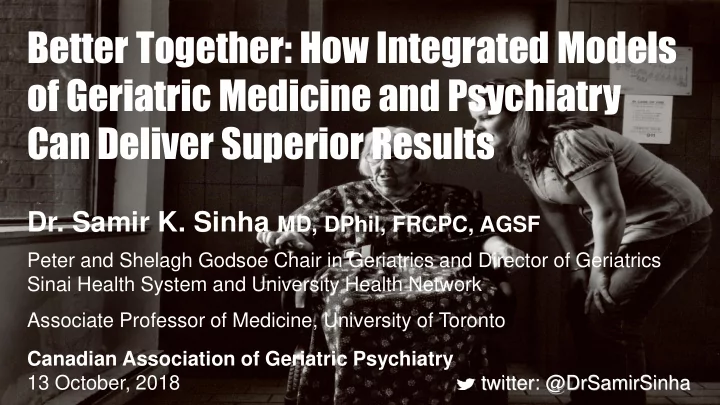

Better Together: How Integrated Models of Geriatric Medicine and Psychiatry Can Deliver Superior Results Dr. Samir K. Sinha MD, DPhil, FRCPC, AGSF Peter and Shelagh Godsoe Chair in Geriatrics and Director of Geriatrics Sinai Health System and University Health Network Associate Professor of Medicine, University of Toronto Canadian Association of Geriatric Psychiatry 13 October, 2018 twitter: @DrSamirSinha
Samir K. Sinha, MD, DPhil, FRCPC, AGSF October 13, 2018 The above presenter has no relevant financial relationship with commercial interests and will not reference unlabeled/unapproved uses of drugs or products in their presentation.
Presentation Objectives Describe why Geriatric Medicine and Psychiatry sometimes have trouble collaborating. Appreciate some Emerging Models of Integrated Care that are developing between the two specialties. Understand the Transformative Impact these models can have.
Geriatrics is a Team Sport
So Why Don’t We Collaborate More? Sometimes we just can’t when the other doesn’t exist. We often don’t train collaboratively, and so it becomes hard to know how to work collaboratively. In some cases we can easily feel threatened by the presence of the other… It takes an investment of time, and continued work to figure out the how to ideally collaborate.
16.9% = 65+
OLDER USERS OF HEALTHCARE | 10% = 60% $$$
Our Journey at Sinai
THE HAZARDS OF HOSPITALIZATION HOSPITAL Acute Illness Functional Hostile Environment Depersonalization Older + Possible Bedrest / Immobility Person Impairment Malnutrition / Dehydration Cognitive Dysfunction Medicines / Polypharmacy Procedures Depressed Mood, Delirium, Physical Impairment and Negative Expectations and Deconditioning Dysfunctional Older Person Palmer et al., 1998 (Modified)
Acute Care for Elders (ACE) Strategy Redesigns or establishes new sustainable approaches that seek to enhance and improve upon current service models. Requires a shift in traditional thinking that currently underpins the administration and culture of most traditional care organizations. Is not adverse to identifying risk factors and needs and in intervening early to maintain independence. Requires a relentless focus on monitoring and evaluating its outcomes to support continuous quality improvement
The Power of Geri Squared We both have expertise that is needed by many patients but not in equal amounts… Others may often confuse us – but we can accept this this and develop integrated pathways that drive better care and efficiencies – ie Shared Hotline, Weekly Rounds We continually check-in to ensure things can evolve constructively.
THE ACE CONTINUUM OF CARE COMMUNITY MODELS OUTPATIENT MODELS Home-Based Geriatric Primary/Specialty Care Program: Outpatient Geriatric Medicine, House Calls Geriatric Psychiatry & Palliative Medicine Clinics Temmy Latner Home-Based Palliative Care Program Telemedicine Clinics Integrated Client Care Management Program Reitman Centre for Alzheimer’s Support and Caregiver Training Community and Staff Education Programs ACUTE CARE Community Paramedicine Program INPATIENT MODELS for ELDERS Community Outreach Team (ACE) STRATEGY Geriatric Medicine, Geriatric Psychiatry & Palliative Medicine Consultation Services Orthogeriatrics Program Intensive Care Unit Geriatrics ED MODELS Program Safe Patients/Safe Staff ISAR Screening ACE Unit Geriatric Emergency Management ACE Unit Home Care Coordinator (GEM) Nurses MAUVE Volunteer Program Geri-EM.com Staff Training Program ACE Tracker Hospital at Home Program New Programs Launched Since Fiscal Year 2010-11 Programs To Be Launched in Fiscal Year 2017-18
HIGH RISK SCREENING AND IDENTIFICATION TOOLS
SAFER PROTOCOLIZED CARE Improving Practice Standards for ACE and Other Patients
INTENSIVE CASE MANAGEMENT THE INTEGRATED CLIENT CARE PROGRAM Starting April 1, 2011 MSH launched a Intensive Case Management Project for up to 60 of its most complicated elders. 2 Home Care Coordinator are assigned to manage the care of these patients throughout the continuum in close collaboration with Geriatric Medicine, Psychiatry and Primary Care Providers. Goal is to ensure these patients access and receive appropriate and integrated care, experience smooth transitions, and are supported to remain at home for as long as possible.
KEEPING CONNECTED TO BETTER MANAGE CARE AND TRANSITIONS
INTEGRATED CONSULTATION TELEMICINE INTEPROFESSIONAL GERIATRICS CONSULTS Starting April 1, 2014 MSH in partnership with CAMH launched an bi- monthly interprofessional telemedicine consult services for complex elders usually majoring in geriatric medicine and psychiatry issues. The Clinics are facilitated by trained Telemedicine Nurses who gather the history, relevant test results and perform cognitive testing. The patient, caregivers and PCP are assessed by both specialties with the support of a community care coordinator and pharmacist. Collaborative recommendations are developed with a follow-up plan.
Patient +/- Caregiver +/- GP and on Screen Home Care w/ TIP RN Coordinator Geriatric Geriatrician Psychiatrist Behavioural Supports Pharmacist d Specialist Homecare Coordinator
95% 95% of primary ary care physicians icians are satisfied with the recommendations offered during the TIP case conference 92% 92% of patien ents ts and their caregivers ivers feel confident that their chronic care will be better managed as a result of TIP
THE OVERALL IMPACT OF ACE +53% -26% -14% +99% $6.7 -93% Million
We Can Influence Policy Together
www.nationalseniorsstrategy.ca
The Power of Geri Squared We both have expertise that is needed by many patients but not in equal amounts… We are growing in numbers and increased opportunities to train together can allow to determine new ways to collaborate and work together as well. Together we can better influence practices and policies at a local and national level.
This is Our Time to Lead
Thank You Samir K. Sinha MD, DPhil, FRCPC, AGSF Director of Geriatrics, Sinai Health System and University Health Network, Toronto Provincial Lead, Ontario ’ s Seniors Strategy samir.sinha@sinaihealthsystem.ca twitter: @DrSamirSinha
Recommend
More recommend